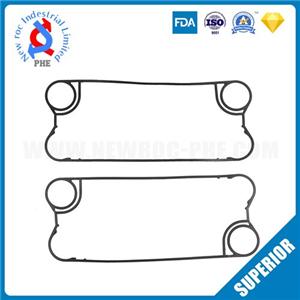What methods should be mastered to install plate heat exchanger gaskets
In order to make the plate heat exchanger gasket play a better effect in the process of use, in addition to selecting the appropriate heat exchanger gasket material, it is also necessary to master the correct installation method. Tell everyone about the correct installation method of plate heat exchanger gaskets.
Plate heat exchanger plates are divided into parallel flow plates and diagonal flow plates according to their heat exchange medium flow patterns. Correspondingly, plate heat exchanger gaskets are divided into parallel flow gaskets and Diagonal flow gasket.
Parallel flow gasket means that the heat exchange medium flowing in from the right corner hole of the heat exchange plate flows out from the right corner hole. Similarly, the heat exchange medium flowing in from the left corner hole flows out from the left corner hole. Diagonal flow gasket means that the heat exchange fluid flows from the right corner hole and then flows out from the left corner hole, or the fluid flowing in from the left corner hole flows out from the right corner hole, showing a diagonal flow pattern. In terms of heat exchange efficiency, the diagonal flow method is better than the unilateral flow, but the cost of the unilateral flow method is relatively low, so when the heat exchange efficiency can be met, the parallel flow method is generally adopted.
What methods should be mastered to install plate heat exchanger rubber pads
Plate heat exchanger gaskets can be divided into three forms according to the different installation methods on the heat exchange plates:
Paste type, that is, after applying sealant on the sealing gasket, it is directly glued to the installation groove of the heat exchange plate.
The snap-on type means that assembly holes are designed on the heat exchange plate, and rubber nails are designed on the side of the heat exchanger sealing gasket. After the sealing gasket is put into the installation groove, the rubber nails are inlaid in the assembly hole.
The hanging buckle type is to design a hanging buckle on the side of the sealing gasket, and use the hanging buckle to buckle the sealing gasket on the heat exchange plate.
For the above three methods, the adhesive heat exchanger gasket has a simple structure and simple processing, but it is relatively troublesome to install and disassemble. Snap-on and hang-on gaskets are complicated in structure and cumbersome to process, but they are relatively easy to install and disassemble. Plate heat exchanger gaskets are divided into symmetrical and asymmetrical shapes according to the product's cross-sectional shape. Symmetrical shapes are generally used for diagonal flow plates. The upper and lower sealing surfaces are flat, symmetrical along the horizontal plane, and can be installed positively and negatively. The asymmetrical ground is a flat surface, and the upper sealing surface can be a flat surface, a curved surface, an inclined surface, etc.




